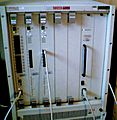Ethernet switch facts for kids
An ethernet switch is a clever device that helps computers and other devices talk to each other in a network. Think of it like a traffic controller for data! It's different from an ethernet hub, which is like a simple traffic light that sends all data everywhere. A switch is much smarter because it knows exactly where each piece of data needs to go, sending it only to the right computer. This makes networks faster and more efficient.
Contents
What is an Ethernet Switch?
An Ethernet switch is a piece of networking hardware that connects devices on a LAN (Local Area Network). It uses packets of data to send information between computers, printers, and other network devices. When a switch receives a data packet, it looks at the packet's destination address. Then, it sends the packet only to the specific port where the destination device is connected.
How Does a Switch Work?
Switches learn the unique addresses of all the devices connected to them. These addresses are called MAC addresses. When a device sends data, the switch records its MAC address and the port it's on. When another device wants to send data to that first device, the switch already knows which port to send it to. This direct connection prevents data from being sent to every device on the network, which saves time and reduces digital "traffic jams."
Switches vs. Hubs
Imagine you have a group of friends, and you want to tell one friend a secret.
- A hub is like shouting the secret to everyone in the room, hoping the right friend hears it. Everyone else hears it too! This can be slow and messy.
- A switch is like whispering the secret directly into your friend's ear. Only the intended person hears it, and it's much faster and more private.
This difference means switches create much more efficient and faster networks compared to older hubs.
Why Use an Ethernet Switch?
Using an Ethernet switch offers several big advantages for a network:
- Better Performance: By sending data directly to its destination, switches reduce unnecessary traffic. This makes the network much faster and more responsive, especially when many devices are sending data at the same time.
- Increased Security: Since data is only sent to the intended recipient, it's harder for other devices on the network to "listen in" on conversations not meant for them.
- Scalability: Switches come in many sizes, from small ones with a few ports for a home network to large ones with hundreds of ports for big businesses or schools. You can easily add more devices as your network grows.
- Reliability: Switches help prevent data collisions, which happen when two devices try to send data at the exact same time. This makes the network more stable and reliable.
Types of Ethernet Switches
There are different kinds of Ethernet switches, each designed for specific needs:
- Unmanaged Switches: These are the simplest type. You just plug them in, and they work automatically. They are great for home networks or small offices where you don't need to control network settings.
- Managed Switches: These switches offer more control and features. Network administrators can log into them to configure settings, monitor network traffic, and troubleshoot problems. They are used in larger networks where more control is needed.
- PoE Switches: Some switches have "Power over Ethernet" (PoE) capabilities. This means they can send both data and electrical power over the same Ethernet cable. This is super handy for devices like IP cameras or wireless access points that need power but might be far from an electrical outlet.
Images for kids
-
Avaya ERS 2550T-PWR, a 50-port Ethernet switch






